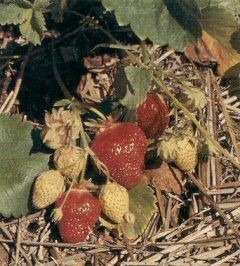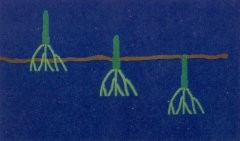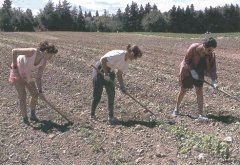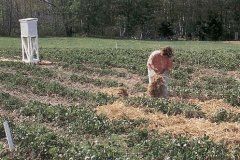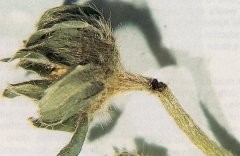SOIL
Good soil is important. Deep sandy loam soils, well supplied with humus, are ideal. They drain well yet hold moisture, which is essential for high yields. Coarse and gravelly soils need more nutrients and water to support a strawberry crop. Poorly drained clay soils are the least suitable because they are difficult to manage and strawberry roots will not grow well in a continuously wet soil.
SOIL PREPARATION
Strawberries planted in well prepared soil should produce fruit for at least five years. An adequate supply of organic matter in the soil is important. Organic matter improves soil structure, provides nutrients, promotes the growth of helpful soil organisms, and increases the water-holding capacity of the soil. If the organic matter content of the soil is low, improve it prior to planting by applying a generous amount of weed-free animal manure, peat moss, or compost. A green manure crop such as buckwheat, grown and incorporated in the soil the year prior to planting, is an excellent method of soil improvement. The New Brunswick Department of Agriculture soil laboratory will analyze soil samples and advise on limestone and fertilizer requirements.
USE OF LIMESTONE
Strawberries are best suited to soils ranging in pH from 5.8 to 6.2. Soils having a pH range of 4.0 to 5.0 are too acid and may be low in calcium and magnesium. Spreading dolomitic limestone results in an increase of soil pH and makes calcium and magnesium more available. If dolomitic limestone is required, you should spread it and work it into the soil one year before planting.
VARIETIES
The list of recommended varieties is frequently revised so contact your nearest regional agricultural office before buying. Varieties presently recommended for the home garden are:
Veestar: Early. Fruit is medium size, medium red, bright, medium firm, good flavour, a good fresh dessert variety, suitable for freezing.
Annapolis: Early. Fruit is large, light to medium red and firm. Recommended as an early fresh dessert variety when resistance to red stele Is required.
Cavendish: Midseason. Fruit is very large, bright medium red, medium firm, good flavour, resistant to red stele.
Glooscap: Midseason. Fruit is medium size to large, medium to dark red, firm, with good flavour and appearance. Produces large yields of berries, suitable for fresh dessert and freezing. Exceptional winter hardiness.
Kent: Midseason. Fruit is large, medium red and firm. Noted for its exceptional yields.
Blomidon: Midseason to late. Fruit is large, maintains size well through season, light to medium red, medium firm, good flavour, picks easily, excellent for fresh fruit.
Bounty: Late. Fruit is large in early pickings but small in later ones, medium red, medium firm, very good flavour, hulls easily. Suitable for fresh dessert and freezing. A good jam variety.
PLANTING SYSTEMS
There are many planting systems. The one best suited to New Brunswick is the matted row. Space the rows 1 m apart and the plants in the row 60 cm apart. Encourage the runners from these plants to root until the desired number of plants develop.
HANDLING PLANTS
Obtain plants as close to planting time as possible. If you cannot plant immediately after receiving the plants, keep them cool and shaded from the sun. If there is a long delay, store them at a temperature above freezing but below 4.50C. If a cold room is not available, dig a narrow trench in well drained soil, space the plants in the trench and firm the soil around the roots. Protect the tops of the plants from direct sunlight and wind. This system will offer protection to the plants for a maximum of one week.
Do not allow plants to dry out during planting. Be extra careful in handling plants when it is sunny and windy. The very fine root system will dry out within a few minutes if not covered. If the roots are dry, place them in water just long enough to wet them and then allow the excess water to drain off. Do not leave the plants submerged in water.
PLANTING
